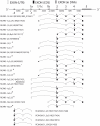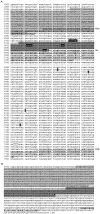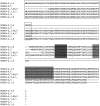Complexity of bidirectional transcription and alternative splicing at human RCAN3 locus
- PMID: 21961037
- PMCID: PMC3178534
- DOI: 10.1371/journal.pone.0024508
Complexity of bidirectional transcription and alternative splicing at human RCAN3 locus
Abstract
Human RCAN3 (regulator of calcineurin 3) belongs to the human RCAN gene family.In this study we provide, with in silico and in vitro analyses, the first detailed description of the human multi-transcript RCAN3 locus. Its analysis revealed that it is composed of a multigene system that includes at least 21 RCAN3 alternative spliced isoforms (16 of them identified here for the first time) and a new RCAN3 antisense gene (RCAN3AS). In particular, we cloned RCAN3-1,3,4,5 (lacking exon 2), RCAN3-1a,2,3,4,5, RCAN3-1a,3,4,5, RCAN3-1b,2,3,4,5, RCAN3-1c,2,3,4,5, RCAN3-1c,2,4,5 and RCAN3-1c,3,4,5, isoforms that present a different 5' untranslated region when compared to RCAN3. Moreover, in order to verify the possible 5' incompleteness of previously identified cDNA isoforms with the reference exon 1, ten more alternative isoforms were retrieved. Bioinformatic searches allowed us to identify RCAN3AS, which overlaps in part with exon 1a, on the opposite strand, for which four different RCAN3AS isoforms were cloned.In order to analyze the different expression patterns of RCAN3 alternative first exons and of RCAN3AS mRNA isoforms, RT-PCR was performed in 17 human tissues. Finally, analyses of RCAN3 and RCAN3AS genomic sequences were performed to identify possible promoter regions, to examine donor and acceptor splice sequences and to compare evolutionary conservation, in particular of alternative exon 1 or 1c--exon 2 junctions in different species.The description of its number of transcripts, of their expression patterns and of their regulatory regions can be important to clarify the functions of RCAN3 gene in different pathways and cellular processes.
Conflict of interest statement
Figures


 ” indicates the DNA region comprised between 24,828,218 and 24,834,337 nucleotides of the chromosome 1 reference sequence NC_000001: it corresponds to the sequence showed in Figure 5A (see Figure 5A legend). 1 described in Strippoli et al., 2000, 2 described in Strausberg et al., 2002, 3 described in Canaider et al., 2006 and 4 described in Facchin et al., 2008. “*” indicates transcripts for which it was not possible to deposit a relative GenBank file. “•” indicates transcripts with exon 1c. “↓” indicates the start codon.
” indicates the DNA region comprised between 24,828,218 and 24,834,337 nucleotides of the chromosome 1 reference sequence NC_000001: it corresponds to the sequence showed in Figure 5A (see Figure 5A legend). 1 described in Strippoli et al., 2000, 2 described in Strausberg et al., 2002, 3 described in Canaider et al., 2006 and 4 described in Facchin et al., 2008. “*” indicates transcripts for which it was not possible to deposit a relative GenBank file. “•” indicates transcripts with exon 1c. “↓” indicates the start codon.




References
-
- Fuentes JJ, Pritchard MA, Planas AM, Bosch A, Ferrer I, et al. A new human gene from the Down syndrome critical region encodes a proline-rich protein highly expressed in fetal brain and heart. Hum Mol Genet. 1995;4:1935–1944. - PubMed
-
- Miyazaki T, Kanou Y, Murata Y, Ohmori S, Niwa T, et al. Molecular cloning of a novel thyroid hormone-responsive gene, ZAKI-4, in human skin fibroblasts. J Biol Chem. 1996;271:14567–14571. - PubMed
-
- Strippoli P, Lenzi L, Petrini M, Carinci P, Zannotti M. A new gene family including DSCR1 (Down Syndrome Candidate Region 1) and ZAKI-4: characterization from yeast to human and identification of DSCR1-like 2, a novel human member (DSCR1L2). Genomics. 2000;64:252–263. - PubMed
-
- Davies KJ, Ermak G, Rothermel BA, Pritchard M, Heitman J, et al. Renaming the DSCR1/Adapt78 gene family as RCAN: regulators of calcineurin. FASEB J. 2007;21:3023–3028. - PubMed
-
- Fuentes JJ, Genesca L, Kingsbury TJ, Cunningham KW, Perez-Riba M, et al. DSCR1, overexpressed in Down syndrome, is an inhibitor of calcineurin-mediated signaling pathways. Hum Mol Genet. 2000;9:1681–1690. - PubMed
Publication types
MeSH terms
Substances
Associated data
- Actions
- Actions
- Actions
- Actions
- Actions
- Actions
- Actions
- Actions
- Actions
- Actions
- Actions
- Actions
- Actions
- Actions
LinkOut - more resources
Full Text Sources
Molecular Biology Databases

